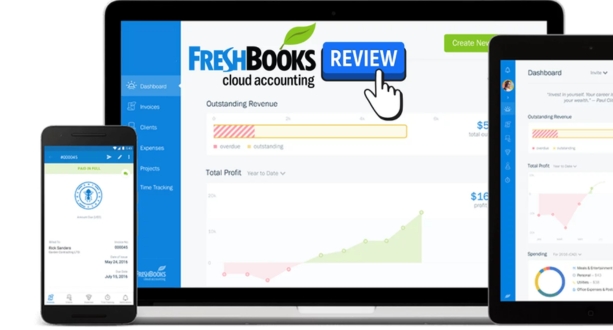Introduction:
Overview of FreshBooks:

FreshBooks is a cloud-based accounting software designed for small businesses and freelancers to streamline their financial management processes. Established in 2003, FreshBooks has evolved into a comprehensive platform that offers a range of features, including invoicing, expense tracking, time tracking, and collaboration tools. It caters to the needs of entrepreneurs and professionals who seek a user-friendly and efficient solution for managing their finances.
The platform’s user interface is intuitive, allowing users to easily navigate through various modules and access vital financial information. FreshBooks‘ emphasis on simplicity, automation, and accessibility has made it a popular choice among small business owners looking for a hassle-free accounting solution. As we delve into financial analysis and reporting, understanding the core features and functionalities of FreshBooks becomes essential for evaluating its impact on the financial management landscape.
Importance of Financial Analysis and Reporting:
Financial analysis and reporting play a pivotal role in the success and sustainability of any business. It involves the examination of financial data, performance metrics, and other key indicators to make informed business decisions. For small businesses, maintaining a clear and accurate financial picture is particularly crucial. Financial analysis helps identify trends, assess the company’s profitability, and make strategic decisions that contribute to growth.
In the context of FreshBooks, understanding the importance of financial analysis is crucial for users seeking to harness the full potential of the software. By comprehending how financial data is processed and presented, users can leverage FreshBooks to gain actionable insights into their business’s financial health. Effective financial analysis not only aids in day-to-day operations but also informs long-term planning and strategic initiatives.
Purpose and Scope of the Analysis:
The purpose of the financial analysis and reporting within the FreshBooks framework is multi-faceted. Firstly, it serves as a tool for users to monitor their cash flow, track expenses, and ensure the financial stability of their business. Through detailed reports and analytics provided by FreshBooks, users can gain a comprehensive understanding of their revenue streams, identify areas for cost-cutting or optimization, and make data-driven decisions.
The scope of the analysis extends beyond basic financial tracking. It includes an exploration of how FreshBooks integrates with other business processes and tools, offering a holistic view of the software’s impact on overall operational efficiency. Furthermore, the analysis can highlight areas where FreshBooks excels and potential areas for improvement, aiding users in maximizing the benefits of the platform for their unique business needs. In essence, the purpose and scope of financial analysis within the context of FreshBooks are integral components for users striving to achieve financial clarity and success in their business endeavors.
Company Background:
Founding and Early Growth:
FreshBooks, a cloud-based accounting software company, was founded in 2003 by Mike McDerment. The inception of FreshBooks can be traced back to McDerment’s frustration with traditional accounting methods. Recognizing the need for a more user-friendly and efficient solution, he developed the initial version of FreshBooks in his parents’ basement. The platform aimed to simplify invoicing and expense tracking for small businesses and freelancers. The early years were marked by bootstrap funding and a lean team, showcasing the entrepreneurial spirit that fueled its establishment. As FreshBooks gained traction, it secured initial rounds of funding, laying the foundation for its sustained growth.
Evolution of FreshBooks’ Business Model:

Over the years, FreshBooks underwent significant evolution in its business model. Initially focused on invoicing and expense tracking, the platform expanded its features to become a comprehensive accounting solution. The company embraced a subscription-based model, offering tiered plans catering to varying business needs. This strategic shift allowed FreshBooks to generate recurring revenue, ensuring financial stability and facilitating continuous product improvement. The integration of cloud technology further enhanced accessibility, enabling users to manage their finances from anywhere. The evolution of FreshBooks’ business model reflects its adaptive approach to meet the dynamic demands of the market and the evolving needs of its user base.
Market Presence and Competitors:
FreshBooks has established a robust market presence in the competitive landscape of accounting software. Its user-friendly interface and focus on small businesses and freelancers set it apart from traditional accounting software giants. The company’s commitment to customer satisfaction and continuous innovation has garnered a loyal user base. However, the accounting software market is highly competitive, with notable competitors such as QuickBooks and Xero. QuickBooks, with its extensive features and widespread adoption, poses a significant challenge. Xero, known for its cloud-based approach, also competes in the same space. FreshBooks differentiates itself through its emphasis on simplicity, customer support, and user experience. Navigating this competitive terrain requires strategic positioning and ongoing efforts to maintain and expand its market share.
Financial Statements Analysis:

Financial Statements Analysis is a critical process that involves evaluating and interpreting various financial statements to gain insights into a company’s financial health and performance. One of the key financial statements examined during this analysis is the Income Statement.
The Income Statement provides a summary of a company’s revenues, expenses, and profits over a specific period, typically a quarter or a year. It is divided into several sections, each offering valuable information for a comprehensive analysis.
Income Statement:
- Revenue and Revenue Recognition:
The first section of the Income Statement focuses on the company’s revenue. Revenue represents the total income generated from the company’s primary business activities. Analyzing revenue is crucial for understanding the top-line growth of the business. Additionally, understanding the company’s revenue recognition policies is vital. Revenue recognition refers to the principles and methods applied by the company to recognize and record revenue in its financial statements. Variations in revenue recognition methods can impact the reported financial performance and should be carefully considered during the analysis.
- Cost of Goods Sold (COGS):
Following revenue, the Income Statement includes the Cost of Goods Sold (COGS) section. COGS represents the direct costs associated with producing or purchasing the goods or services that a company sells during a specific period. Analyzing COGS is essential for evaluating the efficiency and cost-effectiveness of a company’s operations. A decrease in COGS as a percentage of revenue may indicate improved operational efficiency, while an increase could signal rising production costs.
- Gross Margin Analysis:
Gross margin is a key metric calculated by subtracting COGS from revenue. It reflects the profitability of a company’s core operations. Analyzing gross margin over time allows investors and analysts to assess how well a company controls its production costs and how efficiently it converts revenue into gross profit. A consistent or improving gross margin is generally considered positive, indicating effective cost management and pricing strategies. Conversely, a declining gross margin may raise concerns about the company’s ability to maintain profitability.
Dissecting the Income Statement, with a focus on revenue, COGS, and gross margin, provides valuable insights into a company’s operational efficiency, pricing strategy, and overall financial performance. This information is essential for investors, analysts, and other stakeholders seeking a comprehensive understanding of a company’s financial health and prospects.
Balance Sheet
The balance sheet is a fundamental financial statement that provides a snapshot of a company’s financial position at a specific point in time. It is divided into three main sections: Assets, Liabilities, and Shareholders’ Equity.
- Assets:
Assets are the resources owned by a company that have economic value and are expected to provide future benefits. They are classified into two categories: Current Assets and Non-current Assets.
- Current Assets:
Current assets are short-term assets that are expected to be converted into cash or used up within one year. Examples include cash, accounts receivable, inventory, and prepaid expenses. These assets are crucial for the day-to-day operations of the business.
- Non-current Assets:
Non-current assets, also known as long-term assets, are assets with a lifespan exceeding one year. Examples include property, plant, equipment, intangible assets, and long-term investments. These assets contribute to the company’s long-term success and may generate benefits over several years.
- Liabilities:
Liabilities represent a company’s obligations or debts. Similar to assets, liabilities are divided into two categories: Current Liabilities and Non-current Liabilities.
- Current Liabilities:
Current liabilities are short-term obligations that the company is expected to settle within one year. Examples include accounts payable, short-term loans, and accrued expenses. These liabilities are important for assessing the company’s short-term financial health and liquidity.
- Non-current Liabilities:
Non-current liabilities, also known as long-term liabilities, are obligations that extend beyond one year. Common examples include long-term debt, deferred tax liabilities, and pension obligations. These represent the company’s long-term financial commitments and are crucial for evaluating its overall financial stability.
- Shareholders’ Equity:
Shareholders’ equity represents the residual interest in the assets of the company after deducting liabilities. It is the ownership interest of the shareholders in the business. Shareholders’ equity is calculated as the difference between total assets and total liabilities. It includes common stock, retained earnings, and additional paid-in capital.
The balance sheet provides a comprehensive overview of a company’s financial health by presenting its assets, liabilities, and shareholders’ equity. This financial statement is essential for stakeholders, such as investors and creditors, to assess the company’s solvency, liquidity, and overall financial performance.
Key Performance Indicators (KPIs):
Customer Acquisition and Retention:
Customer acquisition and retention are crucial components of any business strategy. KPIs related to these areas help companies assess their success in attracting new customers and keeping existing ones. The customer acquisition cost (CAC) is a key metric, representing the average expense incurred to acquire a new customer. A lower CAC is generally favorable, indicating efficient acquisition strategies.
Retention rates provide insights into customer satisfaction and loyalty. Tracking metrics such as customer churn (the percentage of customers lost over a specific period) helps identify areas for improvement. Analyzing the reasons behind customer attrition enables businesses to refine their offerings and enhance customer experience, ultimately boosting retention.
Monthly Recurring Revenue (MRR) and Annual Recurring Revenue (ARR):
MRR and ARR are essential financial KPIs for subscription-based businesses. MRR reflects the predictable revenue generated each month from subscriptions, while ARR provides an annualized view. Monitoring these metrics allows businesses to gauge their financial health and forecast future revenue streams.
Steady growth in MRR and ARR indicates the success of customer acquisition efforts and highlights the sustainability of the business model. A decline in these figures may signal challenges in retaining customers or acquiring new ones, prompting companies to reassess their strategies.
Churn Rate Analysis:
Churn rate, the percentage of customers who stop using a product or service over a given period, is a critical KPI for assessing customer satisfaction and product/service performance. High churn rates can be indicative of issues such as poor customer experience, lack of product-market fit, or increased competition.
Analyzing churn patterns helps businesses implement targeted interventions to reduce attrition. Customer feedback, surveys, and exit interviews can provide valuable insights into the reasons for churn, allowing companies to make informed decisions and enhance their offerings.
Customer Lifetime Value (CLV):
Customer Lifetime Value represents the total revenue a business can expect to earn from a customer throughout their entire relationship. CLV is a forward-looking metric that considers not just initial transactions but the potential for repeat business over time.
A higher CLV indicates that the business is effectively maximizing revenue from its customer base. By understanding CLV, companies can allocate resources more efficiently, focusing on acquiring and retaining high-value customers. Additionally, CLV aids in setting appropriate marketing budgets and helps businesses prioritize customer satisfaction initiatives for long-term profitability.
Cash Flow Statement:
The Cash Flow Statement is a crucial financial document that provides insights into how cash is generated and utilized by a business over a specific period. It is divided into three main sections:
Operating Activities:
This section outlines the cash flows generated or used in the core business operations of the company. It includes transactions related to revenue, expenses, and working capital. Positive cash flows from operating activities indicate that the company is effectively managing its day-to-day finances.
Investing Activities:
Investing activities focus on the acquisition and disposal of long-term assets. This section includes cash flows related to the purchase or sale of property, equipment, and investments. Positive cash flows from investing activities suggest that the company is making prudent investment decisions for future growth.
Financing Activities:
Financing activities involve transactions with the company’s owners and creditors. This includes cash flows from issuing or repurchasing stock, borrowing or repaying loans, and paying dividends. The financing activities section reflects how the company raises and returns capital. A positive cash flow in this section may indicate the company’s ability to attract external capital or generate returns for its shareholders.
Ratio Analysis:
Ratio analysis is a powerful tool for evaluating a company’s financial performance and health. It involves the calculation and interpretation of various financial ratios, which are categorized into different types:
Liquidity Ratios:
Liquidity ratios assess a company’s ability to meet short-term obligations. The most common ratios in this category are the current ratio and quick ratio. These ratios provide insights into the company’s short-term financial health and its capacity to cover immediate liabilities.
Solvency Ratios:
Solvency ratios focus on a company’s long-term financial viability and its ability to meet long-term obligations. Debt-to-equity ratio and interest coverage ratio are examples of solvency ratios. They help investors and creditors gauge the company’s financial risk and its ability to handle long-term debt.
Profitability Ratios:
Profitability ratios measure the company’s ability to generate profits about its sales, assets, and equity. Common ratios in this category include net profit margin, return on assets (ROA), and return on equity (ROE). These ratios provide insights into the efficiency of the company in converting sales and assets into profits.
Efficiency Ratios:
Efficiency ratios evaluate how effectively a company utilizes its assets and resources to generate sales and profits. Examples include inventory turnover, receivables turnover, and asset turnover ratios. These ratios help assess the operational efficiency and management effectiveness of a company.
Market Trends and Industry Analysis:
The Evolution of Cloud-Based Accounting Software:
In recent years, there has been a significant evolution in the realm of accounting software, with a notable shift towards cloud-based solutions. Traditional on-premise accounting systems are gradually being replaced by cloud-based alternatives due to their inherent advantages. Cloud-based accounting software offers businesses the flexibility to access financial data anytime, anywhere, fostering collaboration among teams and enhancing overall efficiency. This shift has been driven by the need for scalability, cost-effectiveness, and the growing demand for real-time financial insights. As more businesses recognize the benefits of cloud-based accounting, the market is witnessing a surge in adoption, leading to a transformative impact on how financial processes are managed.
Competitive Landscape:
The competitive landscape of the accounting software industry is undergoing constant change, marked by intense rivalry among key players and the emergence of new entrants. Established companies are striving to innovate and differentiate their offerings to maintain or expand their market share. Simultaneously, startups and tech disruptors are introducing innovative solutions, challenging traditional market leaders. The competition is not only limited to feature-rich products but also extends to factors such as user experience, integration capabilities, and customer support. Mergers and acquisitions are common as companies seek to strengthen their market position, enhance their product portfolios, or acquire new technologies to stay ahead in this dynamic and competitive landscape.
Regulatory Environment:
The regulatory environment plays a pivotal role in shaping the accounting software industry. Governments and regulatory bodies worldwide are increasingly focusing on data security, privacy, and compliance, influencing the development and deployment of accounting software solutions. Stricter regulations related to financial reporting and taxation require software providers to incorporate features that ensure adherence to legal requirements. This has led to a growing emphasis on developing software with robust security measures, audit trails, and compliance features. Businesses are compelled to choose accounting software that not only meets their operational needs but also aligns with the ever-evolving regulatory landscape to avoid legal repercussions.
Emerging Technologies and Their Impact:
The accounting software industry is witnessing the integration of emerging technologies that are reshaping traditional processes. Artificial intelligence (AI), machine learning, and automation are being harnessed to streamline repetitive tasks, improve accuracy, and provide actionable insights. The use of data analytics is becoming more prevalent, allowing businesses to extract valuable information from vast datasets for better decision-making. Blockchain technology is also making inroads, offering enhanced security and transparency in financial transactions. The impact of these emerging technologies is not only improving the efficiency of accounting processes but also paving the way for advanced functionalities that were once considered futuristic. As businesses embrace these innovations, the industry is poised for further transformation and increased capabilities in the coming years.
Conclusion
In conclusion, this comprehensive financial analysis and reporting on FreshBooks aim to offer a deep understanding of the company’s financial health, operational efficiency, and strategic positioning within the competitive landscape. By examining key metrics and strategic initiatives, readers can gain valuable insights into FreshBooks’ success and its potential trajectory in the ever-evolving world of financial technology.








